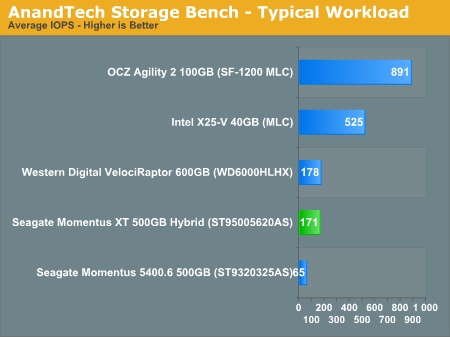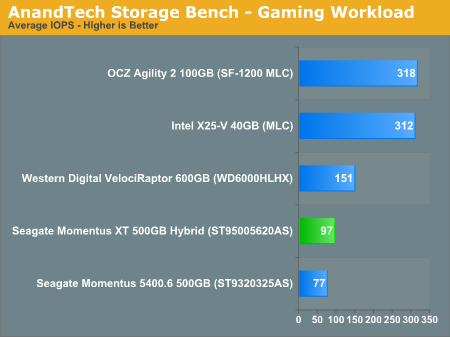Seagate's Momentus XT Reviewed, Finally a Good Hybrid HDD
by Anand Lal Shimpi on May 24, 2010 9:31 AM EST- Posted in
- Storage
- SSDs
- Seagate
- Momentus XT
- Hybrid Drive
- SSHDs
AnandTech Storage Bench
The first in our benchmark suite is a light usage case. The Windows 7 system is loaded with Firefox, Office 2007 and Adobe Reader among other applications. With Firefox we browse web pages like Facebook, AnandTech, Digg and other sites. Outlook is also running and we use it to check emails, create and send a message with a PDF attachment. Adobe Reader is used to view some PDFs. Excel 2007 is used to create a spreadsheet, graphs and save the document. The same goes for Word 2007. We open and step through a presentation in PowerPoint 2007 received as an email attachment before saving it to the desktop. Finally we watch a bit of a Firefly episode in Windows Media Player 11.
There’s some level of multitasking going on here but it’s not unreasonable by any means. Generally the application tasks proceed linearly, with the exception of things like web browsing which may happen in between one of the other tasks.
The recording is played back on all of our drives here today. Remember that we’re isolating disk performance, all we’re doing is playing back every single disk access that happened in that ~5 minute period of usage. The light workload is composed of 37,501 reads and 20,268 writes. Over 30% of the IOs are 4KB, 11% are 16KB, 22% are 32KB and approximately 13% are 64KB in size. Less than 30% of the operations are absolutely sequential in nature. Average queue depth is 6.09 IOs.
The performance results are reported in average I/O Operations per Second (IOPS):

Under typical multitasking workloads that aren't write intensive, the Momentus XT performs much like the new VelociRaptor. This isn't a typical notebook drive at all. We're still far away from even the cheapest SSDs though.
If there’s a light usage case there’s bound to be a heavy one. In this test we have Microsoft Security Essentials running in the background with real time virus scanning enabled. We also perform a quick scan in the middle of the test. Firefox, Outlook, Excel, Word and Powerpoint are all used the same as they were in the light test. We add Photoshop CS4 to the mix, opening a bunch of 12MP images, editing them, then saving them as highly compressed JPGs for web publishing. Windows 7’s picture viewer is used to view a bunch of pictures on the hard drive. We use 7-zip to create and extract .7z archives. Downloading is also prominently featured in our heavy test; we download large files from the Internet during portions of the benchmark, as well as use uTorrent to grab a couple of torrents. Some of the applications in use are installed during the benchmark, Windows updates are also installed. Towards the end of the test we launch World of Warcraft, play for a few minutes, then delete the folder. This test also takes into account all of the disk accesses that happen while the OS is booting.
The benchmark is 22 minutes long and it consists of 128,895 read operations and 72,411 write operations. Roughly 44% of all IOs were sequential. Approximately 30% of all accesses were 4KB in size, 12% were 16KB in size, 14% were 32KB and 20% were 64KB. Average queue depth was 3.59.

Crank up the sequential writes and you lose the benefit of the 4GB of SLC NAND on board the Momentus XT. It still delivers competitive performance with the X25-V thanks to the latter's limited write speeds, and it is faster than a conventional 2.5" drive as read operations still come off the NAND, but you don't get VelociRaptor performance out of it.
The gaming workload is made up of 75,206 read operations and only 4,592 write operations. Only 20% of the accesses are 4KB in size, nearly 40% are 64KB and 20% are 32KB. A whopping 69% of the IOs are sequential, meaning this is predominantly a sequential read benchmark. The average queue depth is 7.76 IOs.

As a benchmark that's bound by sequential read performance it's not surprising to see the Momentus XT not pull ahead here. Remember that we're limited by how quickly data can be streamed out of a single NAND device so you don't see a huge improvement in performance.










120 Comments
View All Comments
dannysauer - Saturday, July 2, 2011 - link
That's a terrible metaphor. A "100 shot" of nitrous is called a "100 shot" because it's good for 100 horsepower. Dyno tests on properly tuned vehicles repeatedly confirm that the advertised power change is usually within a few HP of the documentation.Now that I think about it, I guess it's inadvertently a good metaphor for poorly understanding technology. :)
In any event, you have a good point that it's deceptive to market this as a "hybrid". It's just a regular drive with a large intelligent cache. They should just say "now! with adaptive caching!" or something.
Chloiber - Monday, May 24, 2010 - link
In the beginning you said you would use a Patriot Inferno, but on most benchmarks it says "Agility 2" ?!OT:
This drive should be a perfect upgrade for all notebook users who think SSDs are too expensive or who need more space than the usual 40-120GB of SSDs.
Anand Lal Shimpi - Monday, May 24, 2010 - link
I only used the Inferno for the new tests, the rest was existing data pulled out of Bench. However the two drives perform the same, they are both SF-1200 based 100GB drives with production firmware :)Take care,
Anand
Chloiber - Monday, May 24, 2010 - link
Ah, no problem then, thought it's a copy&paste error :)Aikouka - Monday, May 24, 2010 - link
What I'm curious about is how this drive handles regularly used files that change somewhat often. Caching can be great for executables or libraries (DLLs, etc), given that they don't change often if at all. But what happens when you have files that are accessed during a specific task that may change every time you perform this task? You said that the algorithm doesn't work with writes, which if it understood what write was coming in, it could intercept and possibly alter the already cached data to the new value.This mostly came from a nerdy WoW example where while textures and such don't normally change too often, add-on settings can possibly change every time you load the game (and load-up can be pretty ardruous with a lot of add-ons). So, if these settings files are changing possibly every time, the cache values will be out of date and it'll have to use its poor Random Read rate to access the proper data.
It's really just one drop in the bucket of the many examples you can think of where this drive wouldn't have a problem, but start-up time in WoW is one of the reasons why I went with the Intel X25-M to begin with... when I bought it, it was pretty much top notch in random read performance.
Anand Lal Shimpi - Monday, May 24, 2010 - link
As is the case with any cache there has to be some mechanism to invalidate data in the cache if the original data is modified. I believe that's what happens here. There's a table of LBAs that are cached and if one is modified then the cached version is immediately invalidated and/or updated.Take care,
Anand
Aikouka - Monday, May 24, 2010 - link
Definitely true with cache invalidating.I think I was reading a bit too far into this line:
"the Momentus XT however, the SLC NAND acts exclusively as a read cache - writes never touch the NAND."
and considering that it meant that the caching wouldn't access incoming writes for validating cached data. It sounded odd that way as it'd make caching an absolute sleeping bear of a problem. I'm assuming the statement is meant to be taken literally -- the drive simply doesn't write cache to help speed up writes.
Thanks for the clarification on a sleepy Monday morning and bienvendo!
siberian 3 - Monday, May 24, 2010 - link
Hi Anand do we know what will happen if the NAND fail and not the mechanical part of the drive?Will the user lose the DATA it is on the drive
jaydee - Monday, May 24, 2010 - link
Anand, how do you think this would compare if they chose to do, say 8GB of MLC instead of 4GB of SLC? Surely it would bring the cost down, and I would think the double cache would be more important than the decrease in speed?Chloiber - Monday, May 24, 2010 - link
It has also something to do with reliability/lifetime, not just performance.